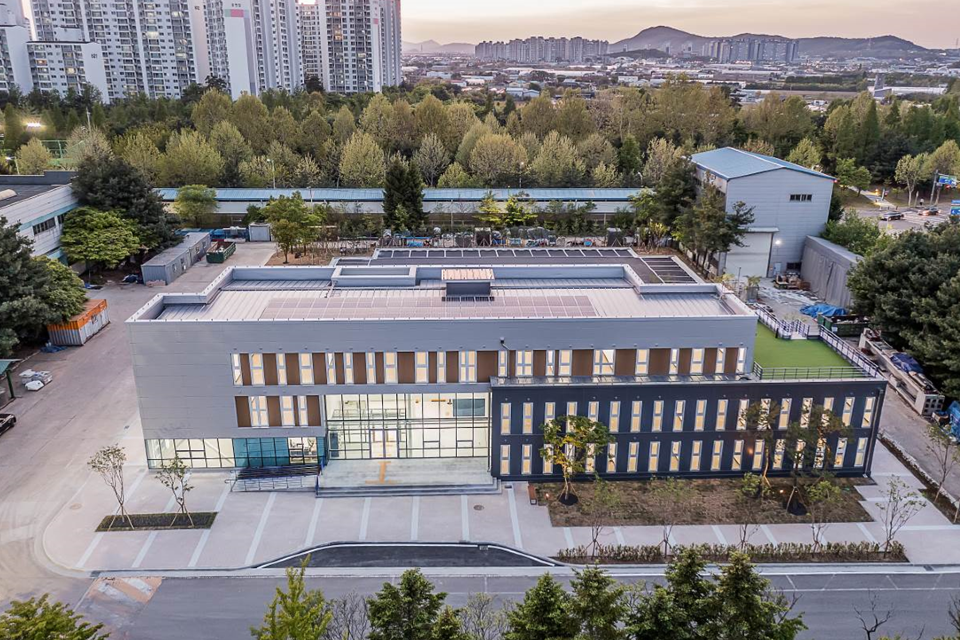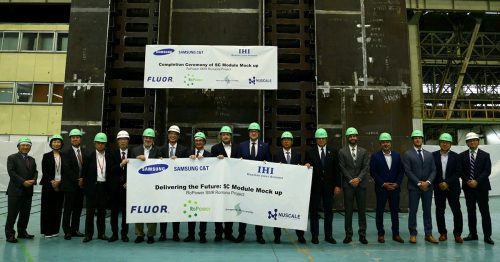Everyone must have built a house with toy blocks at least once in their childhood. A new innovation is taking place in the construction industry, a “modular” construction method that is like assembling blocks.
Samsung C&T Engineering and Construction Group recently completed its first modular building project that is also its first “smart turnkey” project. A turnkey contract is a type of construction contract in which a company takes responsibility for completing everything from the beginning to the end of construction, such as design, construction, and commissioning, and then transfers it to the client. This is a system introduced for efficiency in construction and has the advantage for the construction company of being able to be autonomous in all aspects of the project. This article will take a closer look at Samsung C&T E&C’s modular construction project.
What is modular construction?
Modular construction is defined as producing standardized components of a structure in an off-site factory then assembling them on-site. Manufacturing prefabricated parts of a building in a modular form in the controlled environment of a factory reduces construction time, increases safety and helps improve precision and accuracy. It is also easier to coordinate with high technology features like building information modeling (BIM).
When assembling the modules, there are at least 2 different types: stacked and infill. The stacked type is an assembly method in which structures, floor plates, walls, ceilings, facilities, and interior and exterior finishing materials are manufactured in the form of unit boxes, and then individual units are transported to the site to be stacked horizontally and vertically. The infill type is a construction method in which a hexahedral box module is manufactured at the factory and the infill type module is inserted into the structure like a chest of drawers at the site to complete the building.
Although the idea of modular construction is not itself new, it is currently attracting more interest as a convenient and safe way to build. While it has chiefly been used to make free-standing houses in several countries, the focus has broadened now to constructing larger commercial buildings. As a result, the market size for modular construction is expected to exceed USD 200 billion by 2027.
Building modularly can also lead to a reduced carbon footprint. One study found that 45% less carbon had been emitted than a similar housing construction project that used traditional methods.
A new project in a growing field
For these reasons and more, it is not surprising that Samsung C&T E&C Group is showing interest in this area. The Group’s first modular project was the building of a three-story smart construction support center ordered by the Korea Institute of Civil Engineering and Building Technology. Construction of this three-story building with a total floor area of around 1800 square meters took just 10 months, and the new smart construction support center opened its doors on July 20.
From the outside, the building resembles any other large office complex, but it is composed of 69 modules. Each of these modules was manufactured off-site in a factory and then transported and assembled at the Korea Institute of Civil Engineering and Building Technology. Also, the on-site groundwork was able to proceed at the same time the modules were being prefabricated, shortening the time needed.
Learning new ways to build
As it was the first modular project, there were some concerns, but Samsung C&T took on this project after overcoming fear and resolving to leap into a new field.
In doing so, it partnered with a company, renowned in the modular construction industry. With Samsung C&T E&C leading the way in design and project management, each partner company contributed what it did best, each side learning from the other.
The Samsung C&T E&C Group’s modular team had a strong belief that they had to work hard to learn new fields. The modular team members stayed at their partner’s module manufacturing factory and recorded the size and manufacturing process of the module every day. They thought that the results of these efforts would become the basis for future modular projects.

In order to manufacture modules in advance and secure quality after transport/installation, more precise design is required compared to on-site construction. For this, Samsung C&T introduced Design for Manufacturing and Assembly (DfMA), and Building Information Modeling (BIM) was fully utilized. In addition, pre-simulation of module installation was performed using new technologies such as Mixed Reality (MR).
Using traditional construction methods, it would have taken 11 months to build the smart construction support center at the Korea Institute of Civil Engineering and Building Technology. Using the modular method, it took just 9 months, and there was not a single minor accident on the site.
Having learned from this project, Samsung C&T E&C is pushing to develop key technologies to strengthen its competency. It has applied for several patents related to modular construction, such as a vertical joint structure between modular units, a modular joint system using steel bars, a construction method of block modular buildings, and a modular floor structure that combines steel beams with lightweight concrete panels. Further research and development are being carried out this year to secure joint technology, floor system optimization, and factory manufacturing technology, as well as developing technologies together with expert partners domestically and abroad.
From change to innovation
For the brighter future of the construction industry, it is necessary to improve productivity and reduce dependence on physical labor input. Therefore, it can be said that the future of the construction industry depends on improving productivity through off-site construction.
Samsung C&T E&C Group is approaching modular construction as an innovation of the whole industry, not just a new methodology. The unique characteristic of module construction, namely the production of modules in a stable and controlled factory environment, drives the Group to strive for greater productivity and quality.
The growing interest in the eco-friendly building market trends by companies worldwide has raised interest in sustainable, more efficient, and low-waste ways to build. Samsung C&T E&C Group sees early payoffs in modular construction and is determined to lead the path of innovation in the construction industry in a way that aligns with the eco-friendly market trends.








